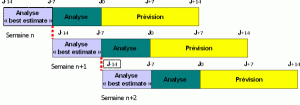An operational numerical forecasting system is the combination of a model configuration and a real time assimilation system. Each week, Mercator Ocean runs a full range of operational systems for analysing and forecasting the ocean in three dimensions.
Analysis is Mercator’s computed sea state based on:
- The numerical model
- Atmospheric forcing
- Two weeks (high-resolution version) or three weeks (medium-resolution version) of data assimilation preceding analysis.
The analysis takes the sea state provided by the model alone and applies actual observations. Such an analysis is the best knowledge of sea state it is possible to have. Only numerical models can currently offer a complete and synoptic 3D view of the ocean taking into consideration all available measurements.
Forecasting
Forecasts depict a future sea state. They are based on the atmospheric surface conditions forecast supplied by weather forecasting numerical models.
The forecast range is the period between the current state and the forecast state.
In the Mercator system, the longest forecast range is 14 days.
Mercator web products are updated weekly. One new analysis and two forecasts are available every Wednesday. The forecasts are for 7 days and 14 days.
The model is run on the Meteo-France VPP 5000 computer every week, during the night of Tuesday to Wednesday.
Every Wednesay (day T0), the Mercator bulletin consists of:
- A daily analysis from T0-14 (14 days before T0) to T0. This analysis combines assimilated data and model outputs. Data are assimilated weekly, on T0-14, T0-7 and T0.
- A daily forecast from T0+1 to T0+14. These fields are from the numerical model only, with no data assimilation.
Mercator thus provides 28 sea states per week, whether analysed or forecast.
The Mercator cycle is described as follows:


